The Orthodox Church, also known as the Eastern Orthodox Church, traces its origins back to the early days of Christianity. It emerged as a distinct branch of Christianity in the 5th century AD, following the Council of Chalcedon in 451 AD. The Orthodox Church has its roots in the ancient Christian communities of the Eastern Roman Empire, particularly in Byzantium (later known as Constantinople). Over the centuries, it developed its own unique traditions, theology, and ecclesiastical structure, becoming one of the major branches of Christianity alongside the Roman Catholic Church.
Table of Contents
History and Origins of Orthodox Christianity
When Orthodox Started
Orthodox Christianity, with its rich history and deep-rooted traditions, has captivated the hearts and minds of millions of believers around the world. But have you ever wondered when and how this ancient faith began? Join us on a journey through time as we explore the history and origins of Orthodox Christianity.
The roots of Orthodox Christianity can be traced back to the early days of Christianity itself. In fact, the word “orthodox” comes from the Greek words “ortho,” meaning straight or correct, and “doxa,” meaning belief or worship. This term was used to distinguish the true believers from those who held heretical views.
The early Christian community was a diverse and vibrant one, with different interpretations of the teachings of Jesus Christ. However, as the faith spread and gained followers, disagreements arose regarding key theological and doctrinal issues. These disputes led to the formation of various sects and factions within the Christian community.
One of the most significant events in the history of Orthodox Christianity was the Great Schism of 1054. This event marked the formal split between the Eastern Orthodox Church and the Roman Catholic Church. The primary cause of the schism was a disagreement over the authority of the Pope and the use of unleavened bread in the Eucharist.
The Eastern Orthodox Church, also known as the Orthodox Catholic Church, traces its origins to the apostles themselves. According to tradition, the apostles spread the teachings of Jesus Christ throughout the Eastern Mediterranean and established vibrant Christian communities in places like Antioch, Alexandria, and Constantinople.
Over time, these communities developed their own distinct liturgical practices and theological traditions. The Eastern Orthodox Church places a strong emphasis on the mystical and sacramental aspects of the faith, with elaborate rituals and a deep reverence for icons and sacred art.
The Byzantine Empire, with its capital in Constantinople, played a crucial role in the development and spread of Orthodox Christianity. The Byzantine emperors saw themselves as the protectors and defenders of the faith, and they used their political power to promote and enforce Orthodox doctrine.
Despite facing numerous challenges and periods of persecution, Orthodox Christianity continued to thrive and spread throughout the centuries. It became the dominant form of Christianity in the Eastern Mediterranean and influenced the development of other Christian traditions, such as the Coptic Church in Egypt and the Ethiopian Orthodox Church.
Today, Orthodox Christianity is practiced by millions of believers around the world. It has a strong presence in countries like Russia, Greece, Romania, and Serbia, where it is the dominant religious tradition. Orthodox churches can also be found in North America, Europe, Africa, and Asia, as a result of migration and missionary efforts.
In conclusion, the history and origins of Orthodox Christianity are deeply intertwined with the early days of Christianity itself. From the apostles to the Byzantine Empire, this ancient faith has weathered storms and flourished throughout the centuries. Its rich traditions and mystical practices continue to inspire and guide believers today, making Orthodox Christianity a vibrant and enduring spiritual tradition.
Key Beliefs and Doctrines of the Orthodox Church

When Orthodox Started
The Orthodox Church, also known as the Eastern Orthodox Church, is one of the oldest Christian denominations in the world. Its origins can be traced back to the early days of Christianity, when the apostles spread the teachings of Jesus Christ throughout the Mediterranean region. Over time, the Orthodox Church developed its own unique set of beliefs and doctrines that continue to shape its practices and traditions today.
One of the key beliefs of the Orthodox Church is the belief in the Holy Trinity. Orthodox Christians believe that God exists as three distinct persons – the Father, the Son (Jesus Christ), and the Holy Spirit – who are all fully God and yet one God. This belief is central to Orthodox theology and is often referred to as the “mystery of the Trinity.”
Another important doctrine of the Orthodox Church is the belief in the Incarnation. Orthodox Christians believe that Jesus Christ, the Son of God, became fully human while still remaining fully divine. This belief is based on the biblical accounts of Jesus’ birth, life, death, and resurrection, and is seen as a central aspect of God’s plan for the salvation of humanity.
The Orthodox Church also places a strong emphasis on the sacraments, which are seen as visible signs of God’s grace. The seven sacraments recognized by the Orthodox Church are baptism, chrismation (confirmation), the Eucharist (also known as Holy Communion), confession, marriage, holy orders (ordination), and unction (anointing of the sick). These sacraments are considered essential for the spiritual growth and salvation of believers.
In addition to these key beliefs and doctrines, the Orthodox Church also has a rich tradition of liturgy and worship. Orthodox worship is characterized by its beauty, reverence, and sense of mystery. The Divine Liturgy, the central act of worship in the Orthodox Church, is a solemn and awe-inspiring service that includes prayers, hymns, scripture readings, and the Eucharist. The use of icons, sacred images of Christ, the Virgin Mary, and the saints, is also an important part of Orthodox worship.
Orthodox Christians also have a deep respect for the saints, who are seen as holy men and women who have lived exemplary lives of faith and devotion. The saints are believed to be alive in Christ and are venerated as intercessors and role models for believers. Icons of the saints are often displayed in Orthodox churches and homes, and believers may ask for their prayers and seek their guidance.
In conclusion, the Orthodox Church has a long and rich history that dates back to the early days of Christianity. Its key beliefs and doctrines, including the belief in the Holy Trinity and the Incarnation, shape its practices and traditions. The sacraments, liturgy, and veneration of the saints are all important aspects of Orthodox worship. Whether you are a member of the Orthodox Church or simply interested in learning more about this ancient Christian tradition, exploring its key beliefs and doctrines can provide a deeper understanding of its faith and spirituality.
The Influence of Byzantine Empire on Orthodox Christianity
When Orthodox Christianity began, it was heavily influenced by the Byzantine Empire. The Byzantine Empire, also known as the Eastern Roman Empire, played a significant role in shaping the beliefs and practices of Orthodox Christianity. This influence can be seen in various aspects of the religion, including its liturgy, art, and architecture.
One of the most notable contributions of the Byzantine Empire to Orthodox Christianity is its liturgical tradition. The Byzantines developed a rich and elaborate liturgy that continues to be used in Orthodox churches to this day. This liturgy is characterized by its use of hymns, chants, and prayers, which create a sense of reverence and awe during worship. The Byzantine liturgy also emphasizes the role of icons, which are sacred images that serve as windows to the divine. These icons are an integral part of Orthodox worship and are believed to facilitate a connection between the worshipper and God.
In addition to its liturgical tradition, the Byzantine Empire also had a profound impact on the art of Orthodox Christianity. Byzantine art is known for its intricate mosaics, frescoes, and iconography. These artistic expressions were not only aesthetically pleasing but also served a theological purpose. Byzantine art aimed to convey the divine presence and the heavenly realm through its use of vibrant colors, gold leaf, and symbolic imagery. The art of the Byzantine Empire continues to inspire Orthodox artists today, who strive to capture the spiritual essence of their faith through their creations.
Furthermore, the Byzantine Empire’s architectural style greatly influenced the design of Orthodox churches. Byzantine architecture is characterized by its domes, arches, and intricate ornamentation. These architectural elements were not only visually striking but also had symbolic significance. The domes represented the heavens and the celestial realm, while the arches symbolized the connection between heaven and earth. The Byzantine architectural style can be seen in many Orthodox churches around the world, with their grand domes and ornate interiors.
The influence of the Byzantine Empire on Orthodox Christianity extends beyond its liturgy, art, and architecture. The Byzantines also played a crucial role in the development of Orthodox theology and doctrine. Many of the early Church Fathers, who shaped the theological foundations of Orthodox Christianity, were from the Byzantine Empire. These theologians, such as St. Basil the Great and St. John Chrysostom, contributed to the formulation of key doctrines, including the Trinity and the nature of Christ. Their writings and teachings continue to be studied and revered by Orthodox theologians today.
In conclusion, the Byzantine Empire had a profound influence on the development of Orthodox Christianity. Its liturgical tradition, art, architecture, and theology all bear the mark of Byzantine influence. The Byzantines’ rich and elaborate liturgy, their intricate art and architecture, and their theological contributions continue to shape the beliefs and practices of Orthodox Christians around the world. The legacy of the Byzantine Empire lives on in the vibrant and enduring tradition of Orthodox Christianity.
Orthodox Liturgy and Worship Practices
When Orthodox Started
Orthodox liturgy and worship practices have a rich history that dates back to the early days of Christianity. The Orthodox Church, also known as the Eastern Orthodox Church, traces its roots to the apostles and the early Christian communities. The liturgy and worship practices that are still observed today have evolved over centuries, shaped by the beliefs and traditions of the Orthodox faithful.
One of the defining features of Orthodox worship is the liturgy, which is a central part of the church service. The liturgy is a structured and ritualistic form of worship that includes prayers, hymns, scripture readings, and the celebration of the Eucharist. It is a communal act of worship that brings together the clergy and the laity in a shared experience of faith.
The origins of the Orthodox liturgy can be traced back to the early Christian communities in the Eastern Mediterranean. In these early communities, worship was simple and informal, with believers gathering in homes or other private spaces to pray and share in the Eucharist. As the Christian faith spread and became more organized, the liturgy began to take on a more formal and structured form.
The liturgy as we know it today began to take shape in the fourth century, with the development of the Divine Liturgy of St. John Chrysostom and the Divine Liturgy of St. Basil the Great. These liturgies, named after two prominent church fathers, became the standard forms of worship in the Byzantine Empire and have been passed down through the generations.
Orthodox worship is characterized by its use of icons, which are sacred images of Christ, the Virgin Mary, and the saints. Icons are not worshipped themselves, but are venerated as windows into the divine. They are believed to be a means of connecting with the spiritual realm and are used as aids in prayer and meditation.
The use of icons in Orthodox worship can be traced back to the early Christian period, when images were used to teach and inspire believers. Over time, the use of icons became more formalized and regulated, with specific guidelines for their creation and veneration. Today, icons are an integral part of Orthodox worship, adorning the walls of churches and homes, and serving as focal points for prayer and contemplation.
Another important aspect of Orthodox worship is the use of incense. Incense is used during the liturgy to symbolize the prayers of the faithful rising to heaven. It is also believed to purify the air and create a sense of reverence and awe. The use of incense in worship can be traced back to the Old Testament, where it was used in the temple rituals of the Jewish people.
Orthodox worship is a sensory experience, engaging the senses of sight, sound, and smell. The use of icons, the chanting of hymns, and the aroma of incense all contribute to creating a sacred atmosphere. This emphasis on the senses is intended to help believers connect with the divine and experience the presence of God in a tangible way.
In conclusion, Orthodox liturgy and worship practices have a long and storied history that dates back to the early days of Christianity. The liturgy, with its structured and ritualistic form of worship, has evolved over centuries, shaped by the beliefs and traditions of the Orthodox faithful. The use of icons and incense, along with the emphasis on the senses, all contribute to creating a sacred atmosphere in which believers can connect with the divine. Orthodox worship is a rich and meaningful experience that continues to be cherished by millions of faithful around the world.
Conclusion
The Orthodox Church traces its origins back to the early Christian community established by the apostles in the first century AD. It developed distinctively from the Western Christian traditions, particularly after the Great Schism of 1054, which led to the separation of the Eastern Orthodox Church from the Roman Catholic Church. The Orthodox Church has since continued to evolve and grow, becoming one of the major branches of Christianity worldwide.
For licensing reasons, we must provide the following notice: This content was created in part with the help of an AI.


